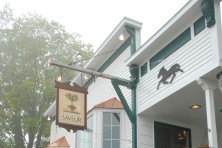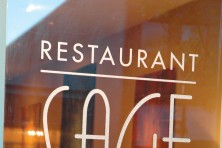Valpolicella, Amarone & Ripasso with William Marks from Restaurant Saveur
- Share
- Tweet
- Pin
- Share
Talk to most baby boomers about “Valpolicella” and a majority of them will say that they remember a rather cheap, non-distinct, fruity red wine that was found on store shelves 30 years ago, right next to the Lancer’s and Mateus. If this was your last taste of wines from the Valpolicella region of northern Italy, (as until recently, it was ours), we urge you to give them another try and so we are devoting this week’s column to some of the regions’ best offerings, starting with basic Valpolicella.
As we said, Valpolicella is not a grape varietal but rather an official viti-cultural zone and a controlled product under Denominazione di Origine Controllata (DOC) laws in northern Italy. It is located in the province of Verona, which is part of the Veneto wine region. Most people believe that the name Valpolicella is derived from an Italian and Greek word mixture meaning “Valley of Cellars,” and wine production in the region dates back more than 3,000 years.
Valpolicella wines are produced primarily from the grape varietals Corvina, Veronese, Rondinella and Molinara, and are made in many styles. Most basic Valpolicellas are light, fragrant table wines, often with notes of strawberry and sour cherry and are best served slightly chilled. The wines can be produced in a nouveau style, similar to Beaujolais nouveau and are often released only a few weeks after harvest. Grapes grown in the original Valpolicella production zone produce Valpolicella Classico. Wines labeled Valpolicella Superiore are aged at least one year and have an alcohol content of at least 12 percent.
Beyond basic Valpolicella, the region is known for several wines produced using a method called appassimento, in which harvested grapes are placed in a dry room (traditionally on straw mats) to dry into raisins before being pressed. The method produces wines that are intensely flavored and high in alcohol content, the most famous of which is called Amarone.
Although Amarone wines have been around for centuries, up until the 1950s it was rarely a deliberate wine style. In 1951, winemakers at Bolla began introducing yeast strains into the wines that could effectively process all the sugars into alcohol, creating completely dry red wines that are both complex and age-worthy. These wines have steadily gained reputation and popularity over the years.
Grapes used for Amarone are the last grapes in Valpolicella to be harvested, getting as ripe as they can before mold and rot set in. The Amarones are then aged for several years with many premium examples being aged for at least five years prior to release. They are often aged in large wooden barrels of either Slovenian or French oak. Amarones are rich, full bodied wines with flavor and aroma notes that are often compared to the flavors of Port wine. The wines often have notes of mocha, bitter-sweet dark chocolate, raisin, dried fig and earthy flavors.
As the production of Amarone has increased in the 21st century, so has the production of ripasso style wines. Literally translated as “repassed,” these vintner’s “second wines” have been gaining popularity in wine circles. Ripasso wines are made from the leftover Amarone seeds and skins that are then blended with basic Valpolicella wine. The introduction of the “leftovers” provides a new food source for the yeasts, and a second fermentation occurs in the Valpollicella. The result is a kind of hybrid wine that has the lightness of basic Valpolicella and some of the complex characteristics of the Amarone.
Santi Valpolicella Classico Superiore Solane Ripasso Veneto Italy 2007
“A nice medium-bodied look with a tinge of autumn orange in the color and slightly off-clear. This wine’s nose has a wet morning mustiness with nice terroir. It has flavors of black cherry and lighter fruits with some pleasant soft tannins on the finish. With the fair amount of acid in this ripasso, it should pair nicely with a number of different dishes. For starters, I would recommend our Jamaican style “jerked” Duroc pork, with grilled pineapple salsa and passion fruit coulis. The Osso buco of Le Québécois natural veal, fresh rosemary papardelle pasta, Roquefort cream, veal braising jus and gremolata would be a natural pairing from the dinner menu. From our lunch menu, I would also recommend this wine to accompany our Masa thickened stew of chicken, chillies, tequila that is served in a grilled pita shell with basmati rice.”
~ William Marks, Restaurant Saveur (Baileys Harbor)
Appearance: Slightly off clear with an orange hue
Aroma: Wet morning mustiness and hints of earthiness
Flavors: Bright berry and black cherry tones
Finishing Notes: Finishes with soft, but ample tannins and a fair amount of acidity
Where to Buy: Main Street Market and Madison Avenue Wine Shop
Where to Try: The Mission Grille and The Whistling Swan
Information about “Where to Try” and “Where to Buy” these selected wines was provided by the local wine purveyors and vendors. If you happen to also serve or sell these wines, email [email protected].
WINE:30 is written by Karl Bradley and Jody Wuollett. Karl is the general manager and self-proclaimed “sous” sommelier for the Mission Grille. Former restaurant executive and Door County native Jody is happily under-employed as a Mission Grille food server and a member of the local band Northbound.



